- ≡ Ptychostomum funkii (Schwägr.) J.R.Spence, Phytologia 89: 113 (2007)
Plants very pale green, catkin-like, occurring as isolated stems among other mosses. Stems red-brown, very short, ≤7 mm, ± branched at base, in cross-section with firm-walled cortical cells and an ill-defined central strand. Leaves larger and crowded near stem apex (but ± uniformly distributed on sterile innovations), erect and imbricate moist and dry, broadly ovate, finely acute, c. 0.8–1.1 mm long (near stem apex) and with lamina 0.9–1.0 the total leaf length, concave, red at base, entire, very weakly bordered and plane at upper margins, not decurrent; upper laminal cells hexagonal-rhombic, thin-walled, c. 45–54 × 12–15 µm and c. 3–4:1, becoming more oblong in lower leaf, and laxly quadrate near alar corners; marginal cells linear and ± thicker-walled to form a very weak (1–3 cells wide), ill- or well-defined border in upper half of leaf; basal cells usually red in 1–2 rows across base. Costa stout at base but rapidly tapered, ± red, short-excurrent or percurrent. Brood bodies (including tubers) absent.
Dioicous. Perichaetia terminal, usually overtopped by innovations. Perigonia terminal. Setae to 40 mm, red, cygneous just below capsule; capsules pendent, narrowly pyriform, 2.5–3 mm, with a well-defined neck c. ¼ –⅓ the total length and wrinkled when dry; operculum conic, weakly apiculate. Exostome teeth yellow-brown; endostome with perforate segments equal in length to the teeth, and appendiculate cilia in groups of 3. Spores 12–15 µm.
Nyholm 1958, fig. 136; Smith 2004, fig. 183, 9–10.
The pale catkin-like plants are distinctive in a N.Z. context and could be confused only with B. argenteum or B. harriottii. The leaves of B. funkii, however, lack the hyaline apical cells of B. argenteum and the two species differ also by sporophytic characters, including capsule size and the nature of their endostomal cilia. Bryum harriottii has rounded leaf apices, less-developed endostomal cilia, and much larger spores.
SI: Otago (Pipsens Creek, White Creek, "West Wanaka").
Bipolar. Reported from Europe and north and central Asia by Smith (2004).
Known from only three Otago L.D. collections, two from streamside gravel with weedy species, including Breutelia affinis, Campylopus clavatus, Ceratodon purpureus, and Dicranoweisia antarctica, and the third from "dry rocks at lakeside". All collections are from c. 350 m elevation.
A report of this species from Banks Peninsula (Macmillan 1996, p. 37) is based on a misdetermination of B. argenteum.
The N.Z. collections of this distinctive species were all made by J.T. Linzey and compare well to European material. There are no compelling reasons to doubt the original determinations of this material by E. Nyholm and A.C. Crundwell.
Smith (2004, p. 568) stated in relation to European collections: "whether the plants currently named B. funkii are the same as that described by Schwägrichen is obscure and likely to remain so".










